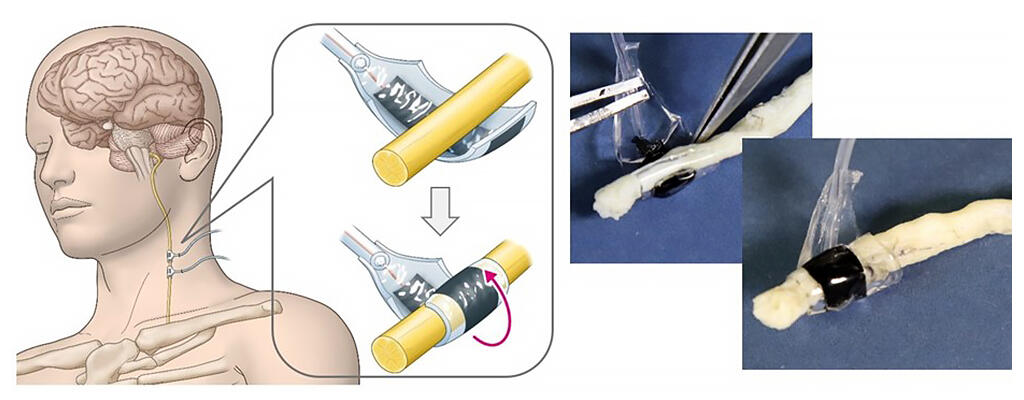It has been reported that stimulation of the vagus nerve through electrodes implanted in the body is effective in relieving epileptic seizures, depressive symptoms and treating heart failure, and so it has been the focus of research studies. However, existing stimulating electrodes consist of a silicone rubber base and a metal such as platinum, making it difficult to maintain safe attachment to delicate nerve bundles. To solve this issue, a joint research group consisting of Professor Matsuhiko Nishizawa and Assistant Professor Daigo Terutsuki of the School of Engineering, Tohoku University and Assistant Professor (Doctor) Shin-ichiro Osawa of Neurosurgery, the School of Medicine, Tohoku University has worked with the Clinical Research, Innovation and Education Center (CRIETO) and succeeded in developing a totally organic electrode for nerve stimulation based on a conducting polymer hydrogel.

Provided by Tohoku University
The research group took on the challenge of developing a 'wrapping electrode (cuff electrode)' that can safely maintain attachment to the delicate nerve bundles; to do this, they made use of previously accumulated hydrogel electrode technology. The key to its development lay in the use of conductive polyurethane (a proprietary development), which naturally curls when attached to a hydrogel base and is elastic enough that it does not impede the shape of the gel. Integrating these meant that the group was able to realize a cuff hydrogel electrode that can stimulate nerve bundles in a safe and stable manner. They also confirmed that, as this is made only of organic materials, it will not create any inappropriate image artifacts during an MRI scan. The group verified the effectiveness of its stimulation and how it maintains stable immobilization of the electrodes to the vagus nerve in an animal experiment with a pig.
In the process of developing this, the group created the conductive polyurethane (PEDOT-PU) by depositing the conductive polymer PEDOT over the pores of a thin polyurethane film. This is an originally developed organic conductive material that combines elasticity (up to 150%), conductivity (<20Ω) and a high capacity (up to 30 mF/cm2); when a PEDOT-PU electrode was sandwiched between two PVA hydrogel films and one side of the sandwiched film was previously stretched, it formed a tube after adhesion. The tube's inner diameter could be controlled within a range of 1-6 mm by the thickness of the PVA films and the strength of the stretching.
Moreover, when the group evaluated the hydrogel cuff electrode's immobilization force when wrapped, they observed that it adequately exceeded the electrode's own weight for both directions of sliding and peeling when attached to a 2 mm-diameter rod. Meanwhile, they learned that the pressure created by the gel wrapping was around 200 Pa, sufficiently less than the 1.3 kPa that can damage the nerves; this was measured with a sensing rod created by the group.
Nishizawa commented on the development, 'This electrode can be applied to electrotherapy as a whole, including stimulating the peripheral nerves, muscle tissue and organs, so in the future we will expand hydrogel electrode variations for diverse tissue shapes by using techniques to control the form of the gel.'
This article has been translated by JST with permission from The Science News Ltd.(https://sci-news.co.jp/). Unauthorized reproduction of the article and photographs is prohibited.




